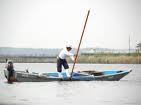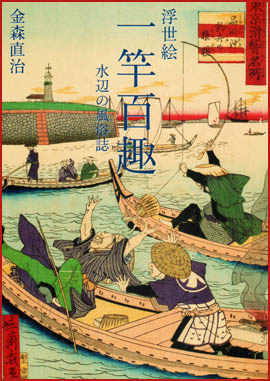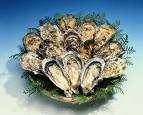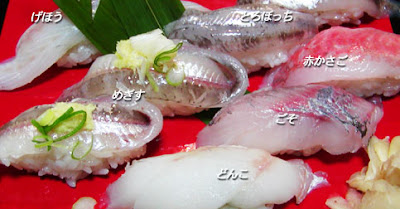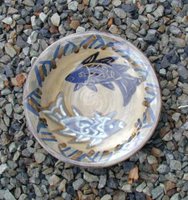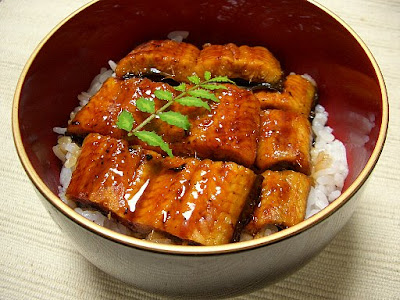::::::::::::::::::::::::::::::::::::::::::::::::::::::::::::::::::::::::::::::::::::::::::::::::::::
Seafood in Summer : FISH
***** Location: Japan
***** Season: Summer
***** Category: Animals / Humanity
*****************************
Explanation
See here for more datails about
Trouts and sweetfish ... the naming
Many fish are found in other seasons too and have an entry of their own.
. Check the ABC KIGO index .
. FISH and SEAFOOD SAIJIKI - START
:::::::::::::::::::::::::::::::::::::::::::::::::::::::::::::::::::::::::::::::::::::::::::::::::::
Early Summer
first bonito, hatsu gatsuo 初鰹 (はつがつお)
see below for bonito
:::::::::::::::::::::::::::::::::::::::::::::::::::::::::::::::::::::::::::::::::::::::::::::::::::
Mid-Summer
. mugiwara dai 麦藁鯛 (むぎわらだい) "straw sea bream" (tai)
. mugiwarahaze, mugiwara hazw 麦藁鯊 (むぎわらはぜ)
"wheat straw dace"
nigoribuna, nigori buna 濁り鮒 (にごりぶな) muddy carp
kind of crucian carp. It swims upriver to spawn and makes the river muddy.
nigori o skuu 濁りを掬う(にごりをすくう)scooping up the mud
. katame no buna 片目の鮒 crucian carp with one eye .
:::::::::::::::::::::::::::::::::::::::::::::::::::::::::::::::::::::::::::::::::::::::::::::::::::
Late Summer
namazu 鯰 (なまず) catfish
Silurus asotus
tsuyu namazu 梅雨鯰(つゆなまず)
gomi namazu ごみ鯰(ごみなまず)
namazunabe, namazu nabe 鯰鍋(なまずなべ) catfish stew
. . . CLICK here for Photos !
Wels
Hyootan, Namazu and Daruma -
The Gourd, the Catfish and Daruma 瓢箪、鯰とだるま
. Catfish Legends and Folk Toys .
:::::::::::::::::::::::::::::::::::::::::::::::::::::::::::::::::::::::::::::::::::::::::::::::::::
All Summer
fish in summer 夏魚 (なつさかな) natsu sakana
..... natsusakana 夏肴(なつさかな)
. . . . .
fighting fish, fish fighting 闘魚 (とうぎょ) toogyo
. . . CLICK here for Photos !
also a special colorful breed called
beta ベタ Betta
siamesischer Kampffisch
Betta splendens
.................................................................................
. Bonito, katsuo / ...gatsuo 鰹
"pine fish" katsuo 松漁
"fish with firm meat" katsuo 堅漁
eboshiou, eboshi uo えぼし魚(えぼしうお)"eboshi fish"
(looking like an official eboshi cap
fishing for bonito, katsuo-zuri 鰹釣
night bonito, yogatsuo 夜鰹(よがつお)
boat for fishing bonito, katsuobune 鰹船
vendor of bonito, katuouri 鰹売り(かつおうり)
time for bonitos, katsuodoki 鰹時(かつおどき)
. . . . but
first bonito, hatsu-katsuo, hatsugatsuo 初鰹 (early summer)
bull trout, iwana 岩魚
kagyoo 嘉魚(かぎょ)
iwana tsuri 岩魚釣(いわなつり)fishing for iwana
iwanagari 岩魚狩(いわながり)hunting for iwana
Cherry salmon, yamame 山女 Oncorhynchus masou;
Literally "mountain lady", "Mountain Maiden".
Cherry Salmon, yamameuo 山女魚
amago あまご, amego あめご, ame no uo あめのうお, enoha えのは
madara まだら, hirabe ひらべ
五月山女(さつきやまめ)
fishing for cherry salmon, yamame tsuri 山女釣
..... A great hobby of many anglers, seen commonly at the local rivers.
yamame, eine Art Bachforelle
:::::::::::::::::::::::::::::::::::::::::::::::::::::::::::::::::::::::::::::::::::::::::::::::::::::
dolphin fish, shiira 鱪 (しいら)
shiira 鬼頭魚(しいら)"demon head fish"
Coryphaena hippurus
Kokerazushi こけらずし Sushi with dolphin fish
:::::::::::::::::::::::::::::::::::::::::::::::::::::::::::::::::::::::::::::::::::::::::::::::::::::
eel, unagi, 鰻、うなぎ, Aal
..... (see also below in Winter)
WASHOKU : Eel dishes (unagi) Japan. Some are kigo
sea eel, conger, anago 穴子 salt-water eel. Meeraal. Congriscus megastomus
pike conger pike, pike eel hamo 鱧 (はも)
Hamo 鱧 pike conger eel History and food
Muraenesox cinereus. dragontooth
:::::::::::::::::::::::::::::::::::::::::::::::::::::::::::::::::::::::::::::::::::::::::::::::::::::
Eso 鮧 (えそ) eso
a kind of flatfish.
akaeso : Synodus ulae
Lives in the warmer waters of Southern regions, and is used as food in Taiwan.
flathead, kochi 鯒 (こち)
fam. Platycephalus
..... megochi めごち
Suggrundus meerdervoortii
. Food with Flathead fish
. "flounder of the castle town" 城下かれい
Pleuronectes yokohamae (Gunther)
flying fish, tobi-uo, tobiuo 飛魚 (とびうお)
.....................tobi no uo, とびの魚
swallow-fish, tsubame-uo つばめ魚
tobira とびら、あご ago
. . . CLICK here for Photos !
..... Flying fish are a delicacy as raw sashimi in many costal areas.
Also called AGO アゴ in Kyushu. The little ones are dried or fried and some are made to broth (tobi-uo dashi 飛魚だし) for ramen soups.
:::::::::::::::::::::::::::::::::::::::::::::::::::::::::::::::::::::::::::::::::::::::::::::::::::::
Gengoro buna 源五郎鮒 (げんごろうぶな) Carassius cuvieri Temminck
kind of crucian carp (buna)
Katadabuna 堅田鮒(かただぶな)buna from Katada town
Gengoroo-Karausche
WKD : Katada / Katata. Famous town at Lake Biwa
goby of a small kind だぼ鯊 (だぼはぜ) dabohaze
..... chichibu ちちぶ、chichikaburi ちちかぶり
Acanthogobius flavimanus. Meeresgrundel
goldfish, kingyo 金魚
Carp (higoi, koi) family Cyprinidae fish
madaragoi 斑鯉(まだらごい)
higoi 日鯉(ひごい)
nishikigoi 錦鯉(にしきごい)brocade carp
. . . CLICK here for Photos !
kawarigoi 変り鯉(かわりごい)
.................................................................................

Hiroshige Woodblock
grunt, isaki 伊佐木/鶏魚 ( いさき)
..... isagi, いさぎ, isegi せぎ, issaki 、いっさき (一先)
..... uzu うず
Best during the rainy season.
Most is caught in the near sea of Sasebo, Nagasaki and the Goto Retto Islands.
:::::::::::::::::::::::::::::::::::::::::::::::::::::::::::::::::::::::::::::::::::::::::::::::::::::
Hasu 鰣 (はす) hasu Alosa reevesii / Hilsa reevesii /Macrura reevesii
Tenualosa reevesii
shigyo ジギョ(鰣魚)
Hilsa Herring, Reeve's Shad, Reeves Shad, Seasonal Shad
hata 羽太 (はた) hata
Epinephelus octofasciatus
. herring in summer 夏鰊 natsu nishin
...........................................................................................

ebi to aji 海老と鯵 - by 広重
horse mackerel, aji 鯵
fam. Carangidae. Rossmakrele, Stachelmakrele
ajiuri 鯵売(あじうり)vendor of Aji
ajiami 鯵網(あじあみ)net for fishing Aji
ajitsuri 鯵釣(あじつり)fishing for Aji
maaji, ma aji 真鯵(まあじ)Trachurus japonicus
muroaji 室鯵(むろあじ) brownstriped mackerel scad
Decapterus muroadsi
yuuaji 夕鯵(ゆうあじ)Aji in the evening
a favorite food of Edo, where it was sold as fresh fish caught during the afternoon.
. Food with horse mackerel 鯵
. . . . .
mame aji 豆あじ very small aji
fished off Odawara, Kanagawa
Mostly eaten as tataki.
They can be eaten whole, after taking the intestines and gills out.
oogon aji 黄金あじ golden aji
fished off Kanaya (Chiba peninsula)
:::::::::::::::::::::::::::::::::::::::::::::::::::::::::::::::::::::::::::::::::::::::::::::::::::::
killifish, medaka メダカ、めだか
himedaka 緋目高(ひめだか)red killifish
shiromedaka 白目高(しろめだか)white killifish
Oryzias latipes
They live in many rivers of Japan and children like to catch them with their bare hands. They bring the feeling of coolness to haiku.
. . . CLICK here for Photos !
Japankärpfling
. Loach (dojoo 泥鰌(どじょう)
fish and food
mackerel, saba 鯖
Scomber japonicus. Makrele
sababi 鯖火(さばび)fire to fish for mackerels
saba tsuri 鯖釣(さばつり)fishing for mackerels
sababune 鯖舟(さばぶね)boat for fishing mackerels
. Saba Mackerels and Food
. saba 鯖と伝説 Legends about mackerel, Makrele .
Manatee (Trichechus manatus) North America
The DUGONG (Dugong dugon) has become a topic for haiku.
. Manta ray, stingray (ei, aka ei 赤鱏 (あかえい)
. parrot fish 石鯛 (いしだい) ishidai
..... shimadai 縞鯛(しまだい)
Oplegnathus fasciatus
rainbowfish, wrasses, bera ベラ(海水魚)
ホンベラ, Halichoeres tenuispinnis
.................................................................................
sculpin, Japanese fluvial sculpin 鮴 (ごり) gori
Cottus pollux, Kaulkopf
. kurodai 黒鯛 クロダイ black sea bream
Acanthopagrus schlegeli
smelt-whiting, silver-whiting キス 鱚 kisu
sand borer. Sillago japonica
The name is written with the characters for fish and happiness.
shirogisu 白鱚(しろぎす)white Kisu
aogisu 青鱚(あおぎす)blue Kisu
magisu 真鱚(まぎす)"real Kisu"
kawagisu 川鱚(かわぎす)"river Kisu"
toragisu 虎鱚(とらぎす)Kisu with tiger pattern
okigisu 沖鱚(おきぎす)kisu in the open sea
Weißling
kisutsuri, kisu tsuri 鱚釣 (きすつり) fishing for sand borers
sole, shitabirame 舌鮃 , tongue fish Solea solea. hirame 鮃
Stone fish, bullhead (okoze 虎魚 (おこぜ, オコゼ ) )
Inimicus japonicus
stripped jewfish, ishinagi いしなぎ
Stereolepis doederleini
gestreifter Judenfisch
. . . . . and
silver jewfish, ishimochi 石首魚 (いしもち)
guchi ぐち、shiroguchi しろぐち
Argyrosomus argentatus. Adlerfisch
.................................................................................
Takabe たかべ takabe
Labracoglossa argentiventris
Lives on the Pacific coast of Honshu and Kyushu.
thread-sail filefish, kawahagi 皮剥 (かわはぎ)
..... hage はげ
Stephanolepis cirrhifer
He has a strong skin and is a well liked delicacy.
Feilenfisch
tropical fish 熱帯魚 (ねったいぎょ) nettaigyo
tenshiui, tenshi uo 天使魚(てんしうお)anglefish
tennin uo 天人魚(てんにんうお)
trout, sweetfish, ayu 鮎
Plecoglossus altivelia
annually coming fish, nengyo 年魚
fragrant fish, koogyo 香魚 (best when roasted near a fire)
Masu and Ayu : Trouts and sweetfish ... the naming
nengyo, fish of the year 年魚(ねんぎょ)
ayuryoo kaisen 鮎漁解禁(あゆりょうかいきん)opening the fishing season for ayu
ayuzushi 鮎鮨(あゆずし)ayu sushi
ayu namasu 鮎膾(あゆなます)ayu with namasu dressing
ayu gyoden 鮎魚田(あゆぎょでん)
koogyoo 香魚(こうぎょ)"fragrant fish"
ayugari 鮎狩(あゆがり)fishing for ayu
ayukake 鮎掛(あゆかけ)trap for ayu fishing
ayu no yado 鮎の宿(あゆのやど)inn for fishing ayu
ayu no sato 鮎の里(あゆのさと)rural area with many ayu
ayu ikesu 鮎生簀(あゆいけす), aquarium for ayu
otori ayu 囮鮎(おとりあゆ)ayu as bait
ayukago 鮎籠(あゆかご)basket to store ayu
ayuryoo 鮎漁(あゆりょう)ayu fishing
ayudoki 鮎時(あゆどき)time for ayu (fishing)
ayumodoki 鮎もどき (あゆもどき) Kissing Loach
..... 鮎擬(あゆもどき)
Leptobotia curta
:::::::::::::::::::::::::::::::::::::::::::::::::::::::::::::::::::::::::::::::::::::::::::::::::::::
white dace 白鮠(しらはえ) shirahae
yamabe やまべ , haya はや, oikawa 追川(おいかわ)
yamabe tsuri やまべ釣り(やまべつり) fishing for yamabe
eine Art Bartgrundel
白鮠甘露煮(しろはやかんろに)shirahae kanroni dish
:::::::::::::::::::::::::::::::::::::::::::::::::::::::::::::::::::::::::::::::::::::::::::::::::::::
yellowtail young, hamachi はまち
Seriola quinqueradiata
inada, tsubasu 津走(つばす), wakashi わかし, wakanago わかなご
fukuragi ふくらぎ
Often served as sushi
junger Gelbschwanz
. . . . . and
kanpachi かんぱち Kampachi, very young yellowtail
..... kanpa かんぱ、akaburi, aka buri 赤鰤(あかぶり)
SEE
Yellowtail, grown up 鰤 Buri
. . . . . and
flat amberijack, hiramasa 平鰤 (ひらまさ)
Seliora lalandi
:::::::::::::::::::::::::::::::::::::::::::::::::::::::::::::::::::::::::::::::::::::::::::::::::::::
Fish as summer food, not in the Saijiki
mekajiki めかじき (眼梶木) swordfish; broadbill
Xiphias gladius
Schwertfisch
*****************************
Worldwide use
*****************************
Things found on the way
*****************************
HAIKU
鱚釣つて父に皓歯をかがやかす
kisu tsutte chichi ni kooshi o kagayakasu
he catches a whiting -
his bright white teeth
all shining
Oogushi Akira 大串章
source : HAIKUreikuDB FISH
:::::::::::::::::::::::::::::::::::::::::::::::::::::::::::::::::::::::::::::::::::::::::::::::::::::

江ノ島や傘さしかけし夏肴
Enoshima ya kasa sashikakeshi natsu sakana
Enoshima island !
all wear a parasol -
fish in summer
Takebe Soochoo 建部巣兆 (たけべ-そうちょう)
1761-1814, painter and poet, Takebe Socho
. Reference : Takebe Socho's haiga
. Enoshima
a small but most famous Benten Island near Kamakura.
*****************************
Related words
Food served on board (funaryoori 船料理 (ふなりょうり))
kigo for all summer
fmi
FISH and SEAFOOD SAIJIKI
[ . BACK to WORLDKIGO TOP . ]
:::::::::::::::::::::::::::::::::::::::::::::::::::::::::::::::::::::::::::::::::::::::::::::::::::::



